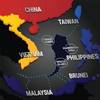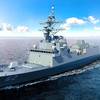The Arctic: NAMEPA Addresses Enviro Issues
NAMEPA’s Environmental Intelligence in Maritime seminar held yesterday in Anchorage, Alaska was the forum for an examination of regulations surrounding resource extraction, and the readiness of response organizations and the government to address environmental challenges posed by this activity in Arctic regions. RADM Tom Ostebo, USCG District 17 Commander was joined by Marilyn Crockett of Alaska Oil and Gas Association, Mark Myers of the University of Alaska, Cam Toohey of Shell Oil Company, Larry Cotter of APICDA, RADM Duncan Smith of Blank Rome, Charles Parks of Tesoro and Ian Dutton of Alaska SeaLife Center.
NAMEPA’s Founding Chairman, Clay Maitland, used the forum to issue a call for recognition of the critical opportunity presented by the Arctic, and the risks involved.
“With the melting of Arctic ice amid rising global temperatures (surface temperatures in 2010 were approximately those of 2005, both being the warmest on record according to the Goddard Institute for Space Studies, a part of the U.S. National Aeronautics and Space Administration), leading the nations that surround the Arctic Circle in a fierce competition to establish new shipping routes and fishing grounds, as well as oil and gas drilling claims. Unfortunately, the United States remains the only major nation, and the only one bordering on the Arctic, that has not ratified the United Nations Convention on the Law of the Sea.” Compounding the challenge is nature itself. “Arctic conditions heighten the risks of drilling, and make any attempt at cleanup of a potential spill far more complicated than in the warm waters of the Gulf of Mexico” observed Maitland.
The program focused on what companies are doing to manage the extraction of resources—offshore drilling, fisheries and cruise—with the resources that are available to mitigate a problem should one arise. Despite efforts to be ready for a marine casualty, “Environmentalists are still unconvinced, asking whether any company has the ability to respond to a major oil spill in hurricane-force winds, high seas, broken and shifting sea ice, subzero temperatures and months of fog and darkness.” stated Mr. Maitland.
The scarcity of resources is a repetitive theme. Said Mr. Maitland “Of greater concern to observers is the relative lack of maritime resources available to governments, particularly the United States. At a time of increasing budget cuts, a question persists: will there be a need for icebreakers on Arctic routes, particularly for transiting vessels, and if so, where will these ships be found? The U.S. Coast Guard has only two icebreakers available at present, one of which is in more or less permanent layup. A third icebreaker is supposedly being updated. China is reportedly building what will be the most powerful conventional icebreaker in the world. The Russian fleet, which includes nuclear-powered icebreakers, is fairly old and of doubtful reliability, much less availability. The cost of a fleet of icebreakers would run into the billions of dollars, and there is no evidence that the congressional will exists to appropriate that sort of money. As a transarctic trade route draws closer to reality, the need for international cooperation in polar and subpolar seas grows greater all the time.”
“Like many other maritime issues, resourcing the northern trade routes lacks the degree of support from the public and from governments, necessary to get the job done. If there was ever a cause to be embraced by the United Nations, the development of an international icebreaker flotilla would seem to be a worthy one.” Maitland concluded.










